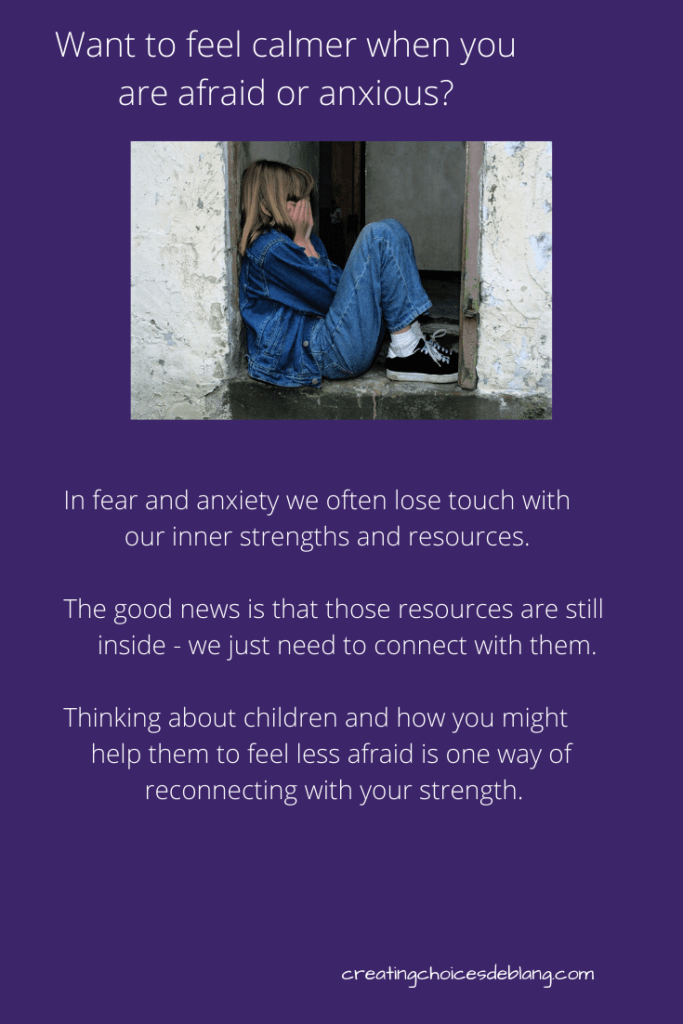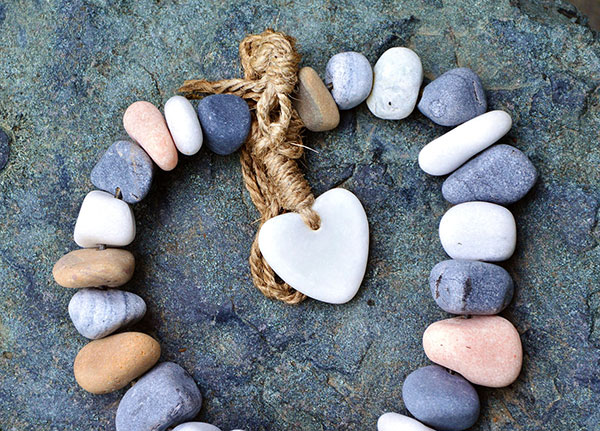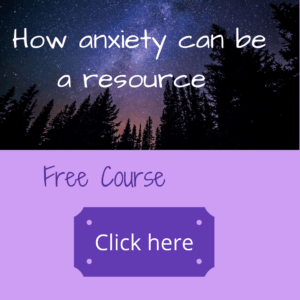
It is pretty understandable to be feeling afraid and anxious with all the unknowns related to the COVID-19 virus.
And no, I don’t mean that COVID-19 is the monster in the closet.
I guess it could be compared to that, since it is scary and unknown.
And, I didn’t think about that when I wrote this –
keep reading and I will explain.
Trying to get rid of fear and anxiety
If you are feeling anxious about all of this, I’m imagining that you would like the anxiety to go away.
You may be hearing or reading articles about how stress is bad for immunity and so you may be
feeling stress about being stressed!
Despite that very natural pull to stop it, I want to encourage you to move toward your fear and anxiety rather than trying to make it go away.
I realize that sounds counterintuitive and your immediate reaction might be, “why in the heck would I want to do that?”
So, here’s where that monster comes in.
The monster in the closet

Imagine for a moment, that your child is afraid of the monster in their closet and comes out to the living room to tell you about it
How might you respond?
Would you be angry with them for bothering you? – well maybe if you had a really stressful day
Would you try to ignore them or somehow make them go away?
What happens when you try to ignore a child who is afraid or try to make them go away?
Clients, who are parents, pretty quickly smile or chuckle and say,
“that would make it worse.”
So, why am I bringing up kids and monsters in the closet?
The brain and fear
I’m bringing it up because the part of our brain reacting to danger is pretty “child-like.”
It is quick to respond to danger and isn’t really good at bringing itself back into balance except by triggering us to run, fight or freeze.

When we are children this is the largest part of our brain.
Our thinking brain slowly develops over time and isn’t fully developed until our 20’s.
So, if you want to have a picture of that part of our brain, using a child is a good way of doing it.
When our emotional brain responds to danger, we need the thinking brain – or in the example of the fearful child – a calm adult to help restore balance.
So, thinking about how we deal with kids is a pretty easy way of thinking about how to deal with the part of your brain that is triggering a fear response to this virus.

When anxiety or fear strikes, it is easy to, without realizing it, jump right in there with the emotional brain and say something like,
“oh, no – this is bad – this is really bad”
Can you bring up a picture in your mind of a parent responding to a child in this way?
What will happen?
Even if you don’t have kids, I bet you know that the child will feel even more afraid.
And yet, this is what we often do when our own internal child is afraid.
Our internal child – the emotional brain
Before I go any further, please know that I am oversimplifying things when I talk about the operation and parts of the brain.
Of course, the brain is much more complicated than this.
The gut and our nervous system are also actively involved in our emotional regulation.
And, thinking about it in this way, is a way you can learn to calm your nervous system.
What the system needs
The childlike emotional brain needs a calm, confident adult, just like that scared child standing next to you.
So instead of trying to ignore or push away fears and anxiety, it is a much more effective strategy to
channel your inner parent,
respond to the fear and
provide the necessary reassurance to calm the system.
But, how am I going to do that?
Let’s go back to the monster in the closet.
What does the child need in that moment?
Your child needs to know that you are paying attention, right?
If they don’t they are going to keep nagging you.

Picture a child tugging on your shirt sleeves saying,
“I’m scared”
And, you ignore them.
Maybe they will go and get distracted and forget about it.
Probably not, if they are really afraid of that monster.
Embrace your fear
So the first step is
being, right there, with your fear rather than trying to avoid it.
Acknowledge the part of you that is afraid,
so it knows you are listening.
And in doing that, your child needs to know you aren’t afraid, right?
So, when you acknowledge the fear,
connect with the part of you that would be the strong adult helping your child with their fear.
Think about the tone of voice you would use.
Think about the expression on your face, how you would hold your body, especially your head and shoulders, that would

let them know that you are there and you are strong.
Take a moment to feel that strength.
And a child would also need to know that there isn’t actually a monster in the closet, right?
They would need to know the facts –
that the noise they were hearing is the wind –
that the fear that you are feeling is from the newscast.
If you are still afraid and anxious or there isn’t an easy answer
Maybe the answer is not as simple as the branch hitting the house. Or maybe you have the facts and
you are still afraid about the virus or anxious about the impacts.
Then what?
I bet you would let your child know
that you are going to be right there with them

as they face this danger, right?
You would be strong for them in that moment.
And you would remind them of the “truth of the moment.”
That in this moment we are safe.
That you will deal with it, if and when, it comes.
If the virus has already come, you would be reminding them of what you are doing, to deal with it, to stay safe.
And then, you switch the focus.
Right?
You don’t sit there talking about the fear over and over until you are right back where you started.
You redirect.
If you are a parent, you have already done this – probably a million times.
Don’t have kids? Imagine one sitting next to you.
If you can’t imagine that, imagine a good friend or a sibling.
I bet you would do the same thing.
And often this is harder for ourselves.
If it is hard for you please don’t be hard on yourself.
it’s a matter of skills and practice
Whether you join in the fear being generated in your emotional brain and make it worse,

or, whether you take the “hand” of this part of your brain and let it know that you are there for it,
is a matter how frightened you are in that moment
and also of skills and experience.
In extreme fright and in facing a life threat, it isn’t reasonable to do this.
And, often times people have trouble doing this for themselves, not because they aren’t good at doing this with others, but because they have never thought of doing this for themselves.
So, it is simply a matter of tapping into a skill that is already there and hasn’t been used.
Thinking about how you would handle this with a child or friend is one way of tapping into this skill.
And, there is another benefit to doing this.
Thinking about how I would handle this with a child or friend,
forces me to “think” which requires the thinking brain and stepping out of the fear!
The skills to deal with fear
If you were lucky, you had an adult who modeled this for you when you were a child, in a consistent enough way, that you internalized these skills.
The adult
- acknowledged your fear
- taught you how to deal with fear and anxiety
- and how to come back into balance.
Important life skills.
And many kids, for whatever reason, don’t internalize these skills and grow up to be adults who lack them.
This often leads to problems with anxiety.
The good news is it isn’t too late to learn them.
If you are one of those who lack these skills and struggle with anxiety, consider signing up for the B.L.O.O.M. interest list.
Right now, I am in the process of developing this skill-based model for dealing with fear and anxiety and it will be available later in the spring.
in summary
This turned out longer than I expected. I guess I had a lot to say 🙂
If you have been a client of mine, you know I love talking about skills to deal with fear and anxiety because they can make such a difference.
Thinking about how you might comfort a scared child is one way of calming your system when you are feeling afraid or anxious.
Think about how you might give:
- acknowledgement,
- confident comforting,
- the facts, and
- distraction.
Try not to keep reminding your inner child of danger by continually reading news reports or posts to social media about the virus.
Stay connected with the facts by, occasionally, checking in with reputable sites like the Center for Disease Control (CDC) website.
Continue to play, connect with friends – by phone if necessary, exercise and do all of those things that you do to keep your kids in balance.
And if you struggle with anxiety you can also check out my free online course, “How Anxiety can be a Resource.”
Or, if getting some individual attention sounds more appealing and you would like to explore the possibility of working with me in online therapy, click here.
If you were hoping for a follow-up to my last article explaining why anxiety traps people, I haven’t forgotten.
And, if you enjoyed this article and would like to receive notification as they are published, scroll down and sign up for the Library.
With warmth and kindness,
Deb



Thank you for this [article], it has been extremely helpful and comforting:-). I think I will be reading it over and over.
Hi Cheri! I feel so grateful for your comment and happy to know that you found the information helpful. with caring, Deb